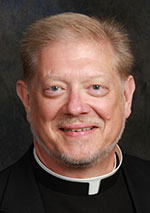That All May Be One / Fr. Rick Ginther
Interfaith and ecumenical resources available for us all
 The Archdiocese of Indianapolis covers a lot of ground: 13,757.7 square miles, which includes 39 counties!
The Archdiocese of Indianapolis covers a lot of ground: 13,757.7 square miles, which includes 39 counties!
We serve 129 parishes and missions—and the majority of those are outside of the greater Indianapolis metro area.
Any organization whose main “headquarters” is located in a city which itself gives its name to the organization struggles to be perceived as “remembering the outlying areas” it serves.
I have lived the experience of having served parishes as “far outlying” as they come: Tell City, Richmond and Terre Haute. Each complained or opined how they seemed forgotten by “the big city,” the “ivory tower” in Indy.
But, like I said, this perception comes with the territory (pun intended).
Interfaith and ecumenical efforts in and among our parishes in central and southern Indiana need close resources upon which to rely. Only then can they remain vibrant and attuned to the current patterns and connections in such ministry.
With this in mind, I am going to highlight two “closer resource cities” for our southern and southeastern parishes.
Louisville, to our immediate south, has some wonderful interfaith resources.
The Center for Interfaith Relations is sponsored in part by the Archdiocese of Louisville. It celebrates “the timeless wisdom contained in the diversity of the world’s faith traditions, honoring the union between thinking globally and acting locally.” Its 24th annual “Festival of Faiths” will take place on April 23-27, 2019. This is a “nationally acclaimed interfaith event of music, poetry, film, art and dialogue with internationally renowned spiritual leaders, thinkers and practitioners.” For more information, go to centerforinterfaithrelations.org.
The Interfaith Center at the University of Louisville houses the offices of Hillel (a Jewish student organization) and Catholic, Episcopal, Lutheran, Presbyterian and United Methodist campus ministries. They provide resources and activities not only to their students and faculty, but to the larger community. More information is available at www.uoflinterfaithcenter.org.
Interfaith Paths to Peace (IPP) is a grassroots community peace organization, established in 1996. It serves the Louisville community, promoting interfaith understanding and peacemaking through programming and events. Go to paths2peace.org for more information.
Cincinnati is to our southeast.
Interfaith Cincy began as a joint academic and interfaith project between the Brueggeman Center for Dialogue at Xavier University and the Jewish Foundation of Cincinnati Fellowship through Hebrew Union College-Jewish Institute of Religion.
Interfaith Cincy has grown into a very large consortium of cooperation. Its goal is to seek out interfaith groups and the services they provide in order to enable them to expand its capacity services. Its website, www.interfaithcincy.org, is also an educational tool designed to strengthen interfaith dialogue.
Interfaith Hospitality Network of Greater Cincinnati (IHNGC) began on Oct. 26, 1991, with a day center and eight congregations which opened up the doors of their churches and synagogues to homeless families.
They have grown to include more than 100 congregational partners, representing people of Protestant, Catholic, Jewish, Muslim and Unitarian faiths. Congregations provide overnight shelter and meals for homeless families in an emergency shelter program.
They have also grown and enhanced the services offered over the years “to provide wraparound support for the whole family that extends beyond emergency shelter.” Go to ihncincinnati.org. for more information.
I hope this information will whet your appetite to learn more about resources in or near our archdiocese. No matter how far we live from the “center,” interfaith and ecumenical resources are at hand.
(Father Rick Ginther is director of the archdiocesan Office of Ecumenism. He is also pastor of Our Lady of Lourdes Parish in Indianapolis.) †
 The Archdiocese of Indianapolis covers a lot of ground: 13,757.7 square miles, which includes 39 counties!
The Archdiocese of Indianapolis covers a lot of ground: 13,757.7 square miles, which includes 39 counties!